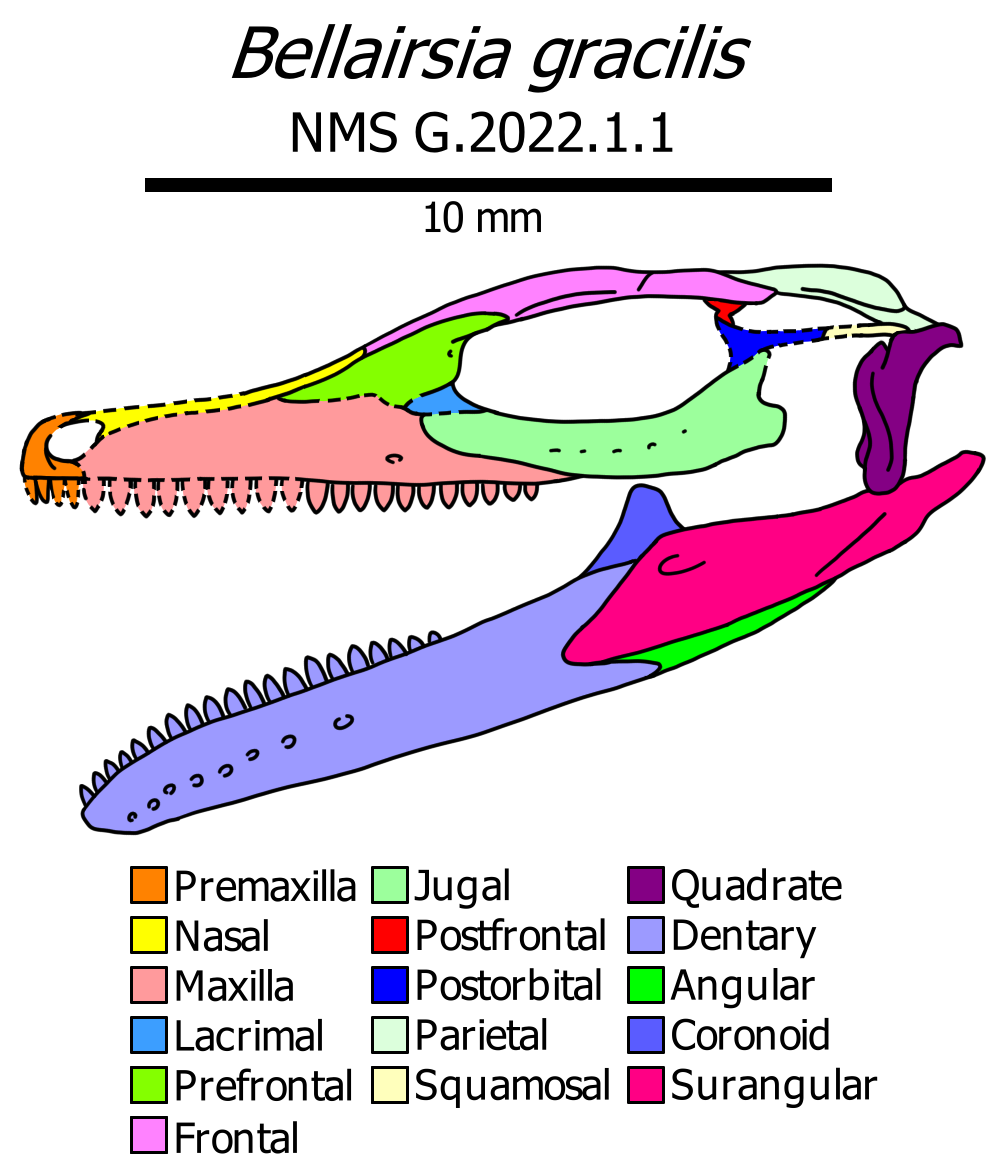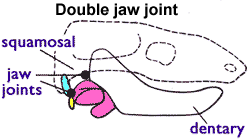|
Wareolestes
''Wareolestes rex'' ("Ware's Brigand king") is a mammaliaform from the Middle Jurassic (Bathonian) rocks of England and Scotland. It was originally known from isolated teeth from England, before a more complete jaw with teeth was found in the Kilmaluag Formation of Skye, Scotland. Etymology ''Wareolestes rex'' was named by Eric Freeman, who named it for Dr. Martin Ware "in recognition of this major contribution" to Freeman's successful work. The second part of the generic name, ''lestes'', comes from the Greek for ''brigand''. The species name ''rex'', Latin for ''king'', is both in recognition of the relatively large size of this Mesozoic mammaliaform, and a pun on the name of Mr E. J. King. Discovery ''Wareolestes rex'' was first found in and named from the Forest Marble Formation of Kirtlington, Oxfordshire, England. The holotype is a single molar tooth, originally described as a lower molar, but later argued to be an upper molar.Hahn G., Sigogneau-Russell D. and Gogefroit P. ... [...More Info...] [...Related Items...] OR: [Wikipedia] [Google] [Baidu] |
Morganucodonts
Morganucodonta ("Glamorgan teeth") is an extinct order of basal Mammaliaformes, a group including crown-group mammals (Mammalia) and their close relatives. Their remains have been found in Southern Africa, Western Europe, North America, India and China. The morganucodontans were probably insectivorous and nocturnal, though like eutriconodonts some species attained large sizes and were carnivorous. Nocturnality is believed to have evolved in the earliest mammals in the Triassic (called the nocturnal bottleneck) as a specialisation that allowed them to exploit a safer, night-time niche, while most larger predators were likely to have been active during the day (though some dinosaurs, for example, were nocturnal as well). Anatomy and biology Morganucodontans had a double jaw articulation made up of the dentary-squamosal joint as well as a quadrate-articular one. This implies that they also retained one of their postdentary bones: the articular. There is a trough at the back of the ... [...More Info...] [...Related Items...] OR: [Wikipedia] [Google] [Baidu] |
Kilmaluag Formation
The Kilmaluag Formation is a Middle Jurassic geologic formation in Scotland. It was formerly known as the Ostracod Limestone for the abundance of fossil freshwater ostracods within it. The Kilmaluag Formation is very fossiliferous, with ostracods, gastropods, bivalves, trace fossil burrows, and vertebrate fossil remains. Vertebrate fossils include fish, crocodylomorphs, mammals, small reptiles, amphibians and some large reptile remains including dinosaurs and pterosaurs.Panciroli E, RBJ Benson, S Walsh, RJ Butler, TA Castro, MEH Jones, SE. Evans. 2020Diverse vertebrate assemblage of the Kilmaluag Formation (Bathonian, Middle Jurassic) of Skye, Scotland Earth and Environmental Transactions of the Royal Society of Edinburgh nline1-22 Geology The Kilmaluag Formation is Bathonian, and dates to around 167 million years old. It is part of the Great Estuarine Group of the Hebrides Basin, a series of sediments laid down as the land rose and fell in the area running between what is now ... [...More Info...] [...Related Items...] OR: [Wikipedia] [Google] [Baidu] |
Morganucodonta
Morganucodonta ("Glamorgan teeth") is an extinct order of basal Mammaliaformes, a group including crown-group mammals (Mammalia) and their close relatives. Their remains have been found in Southern Africa, Western Europe, North America, India and China. The morganucodontans were probably insectivorous and nocturnal, though like eutriconodonts some species attained large sizes and were carnivorous. Nocturnality is believed to have evolved in the earliest mammals in the Triassic (called the nocturnal bottleneck) as a specialisation that allowed them to exploit a safer, night-time niche, while most larger predators were likely to have been active during the day (though some dinosaurs, for example, were nocturnal as well). Anatomy and biology Morganucodontans had a double jaw articulation made up of the dentary-squamosal joint as well as a quadrate-articular one. This implies that they also retained one of their postdentary bones: the articular. There is a trough at the back of t ... [...More Info...] [...Related Items...] OR: [Wikipedia] [Google] [Baidu] |
Forest Marble Formation
The Forest Marble is a geological formation in England. Part of the Great Oolite Group, it dates to the late Bathonian stage of the Middle Jurassic.Weishampel, David B; et al. (2004). "Dinosaur distribution (Middle Jurassic, Europe)." In: Weishampel, David B.; Dodson, Peter; and Osmólska, Halszka (eds.): The Dinosauria, 2nd, Berkeley: University of California Press. Pp. 538–541. . Lithology The primary lithology of the formation typically consists of greenish grey variably calcareous silicate mudstone, with lenticular cross bedded limestone units deposited in a marine setting. Dinosaurian fauna Ornithischians Saurischians Microvertebrate fauna Despite the formation being nearly entirely marine, at several localities abundant remains of terrestrial microvertebrates are found, the primary locality being the Kirtlington Mammal Bed (designated 3p) in Kirtlington Quarry near Kirtlington, Oxfordshire. Another important locality is Watton Cliff near Eype in Dorset. Amp ... [...More Info...] [...Related Items...] OR: [Wikipedia] [Google] [Baidu] |
Mammaliaform
Mammaliaformes ("mammalian forms") is a clade that contains the crown group mammals and their closest extinct relatives; the group radiated from earlier probainognathian cynodonts. It is defined as the clade originating from the most recent common ancestor of Morganucodonta and the crown group mammals; the latter is the clade originating with the most recent common ancestor of extant Monotremata, Marsupialia, and Placentalia. Besides Morganucodonta and the crown group mammals, Mammaliaformes includes Docodonta and '' Hadrocodium'' as well as the Triassic ''Tikitherium'', the earliest known member of the group. Mammaliaformes is a term of phylogenetic nomenclature. In contrast, the assignment of organisms to Mammalia has traditionally been founded on traits and, on this basis, Mammalia is slightly more inclusive than Mammaliaformes. In particular, trait-based taxonomy generally includes ''Adelobasileus'' and ''Sinoconodon'' in Mammalia, though they fall outside the Mammaliaform ... [...More Info...] [...Related Items...] OR: [Wikipedia] [Google] [Baidu] |
Evolution Of Mammals
The evolution of mammals has passed through many stages since the first appearance of their synapsid ancestors in the Pennsylvanian sub-period of the late Carboniferous period. By the mid-Triassic, there were many synapsid species that looked like mammals. The lineage leading to today's mammals split up in the Jurassic; synapsids from this period include '' Dryolestes'', more closely related to extant placentals and marsupials than to monotremes, as well as '' Ambondro'', more closely related to monotremes. Later on, the eutherian and metatherian lineages separated; the metatherians are the animals more closely related to the marsupials, while the eutherians are those more closely related to the placentals. Since '' Juramaia'', the earliest known eutherian, lived 160 million years ago in the Jurassic, this divergence must have occurred in the same period. After the Cretaceous–Paleogene extinction event wiped out the non-avian dinosaurs (birds being the only surviving dinosaurs ... [...More Info...] [...Related Items...] OR: [Wikipedia] [Google] [Baidu] |
Mammaliaformes
Mammaliaformes ("mammalian forms") is a clade that contains the crown group mammals and their closest Extinction, extinct relatives; the group adaptive radiation, radiated from earlier probainognathian cynodonts. It is defined as the clade originating from the most recent common ancestor of Morganucodonta and the crown group mammals; the latter is the clade originating with the most recent common ancestor of extant Monotremata, Marsupialia, and Placentalia. Besides Morganucodonta and the crown group mammals, Mammaliaformes includes Docodonta and ''Hadrocodium'' as well as the Triassic ''Tikitherium'', the earliest known member of the group. Mammaliaformes is a term of phylogenetic nomenclature. In contrast, the assignment of organisms to Mammalia has traditionally been founded on traits and, on this basis, Mammalia is slightly more inclusive than Mammaliaformes. In particular, trait-based taxonomy generally includes ''Adelobasileus'' and ''Sinoconodon'' in Mammalia, though they fa ... [...More Info...] [...Related Items...] OR: [Wikipedia] [Google] [Baidu] |
Hadrocodium
''Hadrocodium wui'' is an extinct mammaliaform that lived during the Sinemurian stage of the Early Jurassic approximately in the Lufeng Formation of the Lufeng Basin in what is now the Yunnan province in south-western China (, paleocoordinates ). It is considered as the closest relative of the class Mammalia. The fossil of this mouse-like, paper-clip sized animal was discovered in 1985 but was then interpreted as a juvenile morganucodontid. ''Hadrocodium'' remained undescribed until 2001; since then its large brain and advanced ear structure have greatly influenced the interpretation of the earliest stages of mammalian evolution, as these mammalian characters could previously be traced only to some . ''Hadrocodium'' is known only from a skull long, and the body mass is estimated to have been , making it one of the smallest Mesozoic mammaliaforms (in contrast, the related ancestral mammal would have been bigger, about ). The name ''Hadrocodium'' alludes to its large cranial ca ... [...More Info...] [...Related Items...] OR: [Wikipedia] [Google] [Baidu] |
Docodonta
Docodonta is an Order (biology), order of extinct Mammaliaformes, mammaliaforms that lived during the Mesozoic, from the Middle Jurassic to Early Cretaceous. They are distinguished from other early Mammaliaformes, mammaliaforms by their relatively complex Molar (tooth), molar teeth, from which the order gets its name. Until recently, Docodonta were represented primarily by teeth and jaws found across former Laurasia, (modern-day North America, Europe, and Asia). However, recent discoveries in China include some exceptionally well preserved, almost complete body fossils. Description Skeletal traits Docodonts have a long and low mandible (lower jaw), formed primarily by the tooth-bearing dentary bone. The dentary connects to the cranium via a joint with the Squamosal bone, squamosal, a connection which is strengthened relative to earlier mammaliaforms. The other bones in the jaw, known as postdentary elements, are still connected to the dentary and lie within a groove (the postd ... [...More Info...] [...Related Items...] OR: [Wikipedia] [Google] [Baidu] |
Haramiyida
Haramiyida ("thief" from Arabic الحرامية (al ḥarāmiyah), "thief, bandit") is a possibly polyphyletic order of mammaliaform cynodonts or mammals of controversial taxonomic affinites. Their teeth, which are by far the most common remains, resemble those of the multituberculates. However, based on ''Haramiyavia'', the jaw is less derived; and at the level of evolution of earlier basal mammals like ''Morganucodon'' and ''Kuehneotherium'', with a groove for ear ossicles on the dentary. If they are early multituberculates, they would be the longest lived mammalian clade of all time. However, a more recent study in November 2015 may dispute this and suggested the Haramiyida were not crown mammals, but were part of an earlier offshoot of mammaliaformes instead. It is also disputed whether the Late Triassic species are closely related to the Jurassic and Cretaceous members belonging to Euharamiyida/Eleutherodontida, as some phylogenetic studies recover the two groups as unrelate ... [...More Info...] [...Related Items...] OR: [Wikipedia] [Google] [Baidu] |
Crown-group
In phylogenetics, the crown group or crown assemblage is a collection of species composed of the living representatives of the collection, the most recent common ancestor of the collection, and all descendants of the most recent common ancestor. It is thus a way of defining a clade, a group consisting of a species and all its extant or extinct descendants. For example, Neornithes (birds) can be defined as a crown group, which includes the most recent common ancestor of all modern birds, and all of its extant or extinct descendants. The concept was developed by Willi Hennig, the formulator of phylogenetic systematics, as a way of classifying living organisms relative to their extinct relatives in his "Die Stammesgeschichte der Insekten", and the "crown" and "stem" group terminology was coined by R. P. S. Jefferies in 1979. Though formulated in the 1970s, the term was not commonly used until its reintroduction in 2000 by Graham Budd and Sören Jensen. Contents of the crown grou ... [...More Info...] [...Related Items...] OR: [Wikipedia] [Google] [Baidu] |




